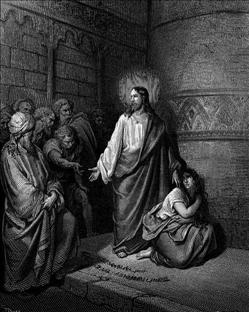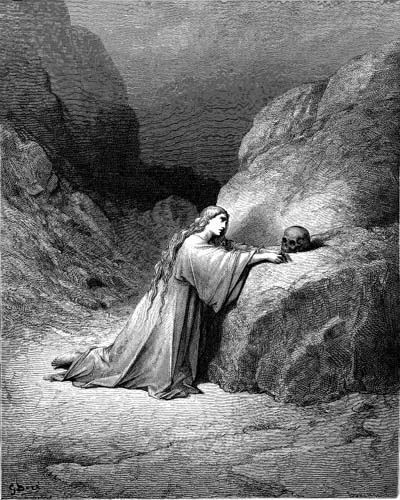

Did Jesus have a sex life? Ever since Chalcedon (a fifth-century
ecumenical council), it has been the orthodox Christian view that
Jesus was "truly God" and "truly man." The Chalcedon definition was a
response to Monophysitism, the heretical view that Christ had a
divine nature only. Fully human (and more), Jesus, says normative
Christianity, shared human needs and desires; born "according to
the flesh" (Rom. 1:4), he was "in all things like his brethren"
(Heb. 2:17).
Yet despite his humanity and the many women whom his ministry attracted, the Bible is silent on any sexual involvement of Jesus. Moreover, statements attributed to Jesus regarding sex are basically negative. Thus a lustful thought is itself adultery (Matt. 5:28). Jesus is liberal in not condemning the woman taken in adultery, but he commands her to "sin no more" (John 8:3-11). He does not accuse the Samaritan woman, living with a man out of wedlock, of immorality, but that may be because she changes the subject when Jesus brings it up (John 4:5-26).

Jesus
even refers to "eunuchs for the kingdom of heaven's sake" (Matt.
19:12), an apparent endorsement of sexual abstinence for those so
inclined. Others should perhaps enjoy sex while they can, for Luke
20:33-36 quotes Jesus as saying there will be no marriage in the
resurrection. In other words, there ain't no sex in heaven.
It can be argued that the ascetic portrayal of Christ in the gospels reflects not the historical Jesus but an antisexual attitude, under Hellenistic influences, that developed in the early church, before the four gospels were written. One can then try reading between the lines for a sex life of Jesus, and it's intriguing what some people find. The Rev. Robert Williams, for example, finds what we might call the Gay Galilean. As Anglican Bishop Hugh Montefiore did decades ago, Williams suspects a homosexual lover in the unnamed "beloved disciple" in the Gospel of John, the disciple "whom Jesus loved" and who "was leaning on Jesus' bosom" at the last supper (John 13:23).
Being gay would also explain why Jesus was unmarried, since Jewish rabbis and priests customarily had wives. But then Protestant theologian William E. Phipps and Episcopal Bishop John Shelby Spong suggest that Jesus was married, the missus most likely being Mary of Magdala. According to the non-canonical Gospel of Philip, Jesus loved "his companion" Mary Magdalene more than all the other disciples, and often kissed her on the mouth, to the annoyance of the other disciples. No less a group than that the Jesus Seminar, an international group of biblical scholars formed in 1985, has expressed the view that Jesus and the Magdalene probably had "a special relationship." The Australian author Barbara Thiering not only has Jesus marrying Mary, who bears him three children, but then has her divorcing him, after which Jesus weds Lydia, a traveling saleswoman who later entertains Paul (Acts 16:14-15). This might have made a good novel, but Thiering's work is classed as nonfiction.
In any case, theories or fantasies about Jesus' sex life must remain speculation. And among conservative Christians one can still find some Monophysites in sheep's clothing. To them, the very idea of a sexually active Jesus, giving in to erotic desire, is taking 1 John 4:7, "Let us love one another," too far. (Consider the highly publicized furor over the 1988 film version of Nikos Kazantzakis's novel The Last Temptation of Christ, in which Jesus only dreams about having sex.)
The Bible goes pretty far, though, metaphorically. As Yahweh takes Israel as his bride (Isa. 54:5; 62:4-5; Ezek. 16), so Christ's love for the church is compared to that of a man for his wife (Eph. 5:22-32). "I have espoused you to one husband," Paul tells the Corinthian church, "that I may present you as a chaste virgin to Christ" (2 Cor. 11:2). In the Apocalypse, "the holy city, new Jerusalem," is "the Lamb's wife," descending from heaven "as a bride adorned for her husband" (Rev. 21:2, 9-10). "The marriage of the Lamb is come," says Saint John, "and his wife hath made herself ready" (Rev. 19:7).
The love imagery becomes sexually explicit in the Song of Solomon, insofar as the lovers in that fine piece of Old Testament erotica have down through the ages been interpreted by many as an allegory of Christ and the church. But that interpretation is something of a stretch, given the song's straightforward eroticism. And then there's the quaintness, by modern standards, of some of the lovers' cooings. While the line "The joints of thy thighs are like jewels" might pass muster, I don't think any woman today would be flattered to hear that she has hair like "a flock of goats" (4:1), eyes like "the fishpools in Heshbon" (7:4), or a nose like "the tower of Lebanon which looketh toward Damascus" (7:4).



Copyright 2000 by Ronald L. Ecker
Contact:
hobrad at outlook dot com
dragonswood at comcast dot net
Back to Top | Acre | The Ron Ecker Home Page